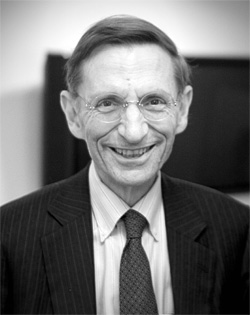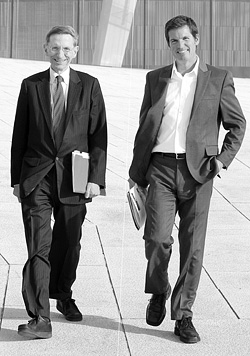How Do You Change the World?
Become a Social Entrepreneur
By Scott London
As a journalist, I first started covering social entrepreneurship about twenty years ago. At the time, people had no idea what I was talking about. But today the term is cropping up in cover stories and op-ed pieces, in keynote addresses at global conferences, in the curricula of our best colleges and universities, and in a growing body of literature—much of it quite impressive and inspiring.

Bill Drayton
The rise of social entrepreneurship reflects a growing sense today that many of the most promising solutions to global problems don’t necessarily depend on charity, government aid, or foundation grants. They come from individuals at the grassroots level willing to bring entrepreneurial thinking to bear on some of our toughest social problems.
Social entrepreneurs apply market principles to the business of social change. A case in point is Anita Ahuja in India. She has tackled problems like waste, sanitation and unemployment by launching a venture that makes wallets, purses, and other high-end accessories out of plastic waste.
No one has done more to put social entrepreneurship on the map than Bill Drayton. In fact, he’s widely credited with having coined the term in the early 1980s. He’s the CEO and founder of Ashoka, a global association of social innovators. Since 1981, the organization has elected some 3,000 leading social entrepreneurs as Ashoka Fellows, providing them with living stipends, professional support, and access to an outstanding global network of peers.
I caught up with Drayton in Oslo, Norway, to talk about the movement he started and how it’s evolving.
![]()
Scott London: It’s been 35 years since you first started using the phrase “social entrepreneurship.” Now suddenly everybody wants to be a social entrepreneur. It’s almost as if the concept suddenly went viral.
Bill Drayton: When we started, there was no word for this field. If you don’t have a word, it tells you that not much is going on. But today, as you pointed out, everyone wants to be a social entrepreneur. Universities all over the world have courseware on the subject. For example, almost all of the second-year students at Harvard Business School are now taking courses on it. That’s new.
London: Why is it catching on now?
Drayton: It’s building because the rate of change is going up exponentially. Change by one person affects the next group of people, and so on. So change begets change. But we live in a world that as been organized around repetition, which is the opposite of change. Institutions are created in the name of efficiency and repetition. The accelerating rate of change is breaking that system.
London: It’s remarkable how quickly organizations seize on words like “innovative” and “entrepreneurial” to describe efforts that are anything but. Does that bother you?
Drayton: Well, it’s inevitable. You can’t prevent people from aspiring.
London: Or seizing on new ideas and calling them their own.
Drayton: It’s good that people want to be social entrepreneurs. We need everyone wanting to be a changemaker. You have to have entrepreneurs. They keep the whole system moving for the good of all. That’s what defines a social entrepreneur—the motivation from deep within to serve the whole and to make sure that solutions are sustainable, fair, and efficient.
London: I think we all resonate with the idea that everyone can be a changemaker. But it’s counterintuitive because there is something in our nature as human beings that’s deeply resistant to change.
Drayton: Very young children learn by doing. As they grow up they discover the joy in learning. But when they become adults—after they have grasped a body of knowledge and a set of rules—most of them become aggressively defensive of that body of knowledge. They see it as their ticket and they don’t want to change. But this is because we have built a structure for repetition. We have people in school with the idea that they have to master a body of knowledge and its associated rules and then keep on repeating that. This is what needs to change.
London: Isn’t there some truth to the idea that we lose our youthful idealism naturally as we get older.
Drayton: Well, some people lose it, but many don’t. There is nothing necessary about that. Some of the best entrepreneurs are in their eighties. What we want to see is a world where everyone, no matter where they are in their lifecycle, is unafraid of problems and takes joy in learning.
London: My experience has been that young people are especially attracted to the idea of social entrepreneurship.
Drayton: Yes. But young people, like the rest of us, need to be empowered to become changemakers. If they can join together in their middle school or high school and set up a virtual radio station or a tutoring service or a music academy, or whatever, and then build a team, it can work. Our experience is that for every young social entrepreneur with an idea, there are 20 more who want to work to make it happen. That means that if you have five or six entrepreneurs in a school, you have over a hundred kids saying to their peers, “Come and join us, use our service, it’s really cool.” And then the kids educate each other and it becomes easy.
London: How to we empower the next generation to start social ventures?
Drayton: The first step is for young people to be practicing change. We’ve got to help every school and every youth community make the change so it becomes natural for kids to start things. Once young people see themselves as changemakers, the world will be on a very different path—a path that is limitlessly hopeful.
London: What’s the toughest challenge facing social entrepreneurs today?
Drayton: The biggest problem we have is that people don’t yet see the change that’s going on. Once people understand that we are moving from a world of repetition to a world of change, then the role of the social entrepreneur becomes obvious. You cannot have the problems outrun the solutions when everyone is a changemaker. We become like smart white blood cells. We see a problem and move right to taking care of it. But right now we’re in the middle of a transition, and people don’t see it clearly. Once we break through the awareness gap and people realize that society is making this change, and more and more people step up and really make a difference, then it will become very obvious. Then people can figure out what it means for them as parents, as leaders of institutions, or as young people.
London: Where do you see the field in, say, ten years?
Drayton: We will be over the awareness tipping point. Many of the institutions that are organized around repetition will begin to fade very quickly. Of course, there will always be some repetition—we’ll probably still have to wash the dishes. But the value is increasingly going to be in change and we will recognize that we’re living in a new strategic environment.
London: Where does this leave the whole field of philanthropy? Will the rise of social entrepreneurship render traditional grantmaking increasingly obsolete or irrelevant?
Drayton: I certainly hope so! [Laughs] Individuals in the field are doing their best, but it’s structurally flawed. Foundations don’t have to listen to their clients. If you don’t listen to your clients, especially as things move faster and faster, you fall behind, no matter what sector you’re in. This is not a criticism of the people in traditional philanthropy. The problem is structural. So we have to invent a set of new financial instruments. We’re doing that.

With Bill Drayton outside Oslo's
beautiful Opera House
The social investment bond is one example. Ashoka has demonstrated that when you tear the wall down between business and society, instead of having a business system and a social system that don’t talk to one another, you take the strengths of each. The citizen sector has lower costs closer to the clients. The business sector has better access to capital and has certain efficiencies. When you put those together, the hybrid business-social value-added chain is much more powerful. Now look at what that does economically. In every hybrid value chain that we’ve done so far, the citizen group gets a huge flow of money.
London: Can you give me an example?
Drayton: In India, houses for informal sector workers are not being built. There are almost 25 million missing housing units. The citizen sector is no good at real estate, but they are low-cost and have deep knowledge of communities. The builders can’t deal with the vegetable-seller who doesn’t have a pay stub, but they know real estate. When you put these two together, the citizen sector sells, makes lending decisions, administers technical assistance, and handles collection, while the builder builds, the financial sector finances, and the houses get built. So far we’ve had 15,000 buildings constructed in 14 months. $120 million of private capital. When you do the math, you see that it’s a $340 billion market. This is an example of just how radically the system is going to change. And there is a wave of social entrepreneurship in finance now. So I think it’s going to change fast.
London: What do people in government have to learn from social entrepreneurs?
Drayton: The social entrepreneur is both a spur and an ally of government. Over half the Ashoka fellows change national policy—that means government—within five years of their launch. If you’re a government minister, wouldn’t you want to find sources of innovation in your field and encourage them? If you’re recruiting people for government, where could you go that would be better than experienced people from the citizen sector? And especially the entrepreneurs—they have the intellectual capital. No one knows things at greater depth than the social entrepreneur whose job it is to cause structural social change. So entrepreneurs can make you feel uncomfortable. They can do things a lot better, a lot cheaper, and a lot faster. That can be a big benefit, but you have to overcome the discomfort.
London: You make the case that individuals and organizations are better off supporting social entrepreneurs—such as the Ashoka fellows—rather than directly supporting and giving money to the causes they care about. Why?
Drayton: When you invest in Ashoka fellows, you can count on the fact that over half of them will change national policy in their respective countries. Ten years of evaluations have shown this to be true. You can also count on the fact that they will recruit thousands of local changemakers in the field, the next generation of entrepreneurs. In addition to that, you can count on these entrepreneurs to work together. This is an incredibly powerful form of collaborative entrepreneurship. It’s never been done before. Now, how could you possibly find a more powerful investment, especially since this is an investment that grows every year? The entrepreneurs, the policy impacts, and the collaborative entrepreneurship—every year the combination becomes more and more powerful.
London: A lot of people are anxious about the quickening pace of change today. But you’re clearly very optimistic about the future.
Drayton: There is nothing unstable about a world where everyone is a changemaker. Once you know how to really understand and empathize with others, how to work in teams, and how to lead in a new and collaborative way, problems are solved before they get out of hand. Deep divisions and prejudices between groups fall away. And it leads to a more peaceful world. To be a changemaker is very satisfying because you become a giver. And we all know that being a giver means a longer life, a healthier life, and a happier life.
This interview took place at the 2012 Partnership for Change conference in Oslo, Norway, in March 2012. (Photos by Bjørn Bragi Asgeirsson.)
